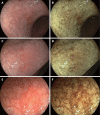Diagnosis of extent of early gastric cancer using flexible spectral imaging color enhancement
- PMID: 22912909
- PMCID: PMC3423516
- DOI: 10.4253/wjge.v4.i8.356
Diagnosis of extent of early gastric cancer using flexible spectral imaging color enhancement
Abstract
The demarcation line between the cancerous lesion and the surrounding area could be easily recognized with flexible spectral imaging color enhancement (FICE) system compared with conventional white light images. The characteristic finding of depressed-type early gastric cancer (EGC) in most cases was revealed as reddish lesions distinct from the surrounding yellowish non-cancerous area without magnification. Conventional endoscopic images provide little information regarding depressed lesions located in the tangential line, but FICE produces higher color contrast of such cancers. Histological findings in depressed area with reddish color changes show a high density of glandular structure and an apparently irregular microvessel in intervening parts between crypts, resulting in the higher color contrast of FICE image between cancer and surrounding area. Some depressed cancers are shown as whitish lesion by conventional endoscopy. FICE also can produce higher color contrast between whitish cancerous lesions and surrounding atrophic mucosa. For nearly flat cancer, FICE can produce an irregular structural pattern of cancer distinct from that of the surrounding mucosa, leading to a clear demarcation. Most elevated-type EGCs are detected easily as yellowish lesions with clearly contrasting demarcation. In some cases, a partially reddish change is accompanied on the tumor surface similar to depressed type cancer. In addition, the FICE system is quite useful for the detection of minute gastric cancer, even without magnification. These new contrasting images with the FICE system may have the potential to increase the rate of detection of gastric cancers and screen for them more effectively as well as to determine the extent of EGC.
Keywords: Early gastric cancer; Endoscopic submucosal dissection; Flexible spectral imaging color enhancement; Magnified image; Nonmagnified image.
Figures






References
-
- Miyake Y, Sekiya T, Kubo S, Hara T. A new spectrophotometer for measuring the spectral reflectance of gastric mucous membrane. J Photogr Sci. 1989;37:134–138.
-
- Knyrim K, Seidlitz H, Vakil N, Classen M. Perspectives in “electronic endoscopy”. Past, present and future of fibers and CCDs in medical endoscopes. Endoscopy. 1990;22 Suppl 1:2–8. - PubMed
-
- Tsumura N, Tanaka T, Haneishi H, Miyake Y. Optimal design of mosaic color filters for the improvement of image quality in electronic endoscopes. Opt Commun. 1998;145:27–32.
-
- Haneishi H, Shiobara T, Miyake Y. Color correction for colorimetric color reproduction in an electronic endoscope. Opt Commun. 2003;114:57–63.
-
- Osawa H, Yoshizawa M, Yamamoto H, Kita H, Satoh K, Ohnishi H, Nakano H, Wada M, Arashiro M, Tsukui M, et al. Optimal band imaging system can facilitate detection of changes in depressed-type early gastric cancer. Gastrointest Endosc. 2008;67:226–234. - PubMed
LinkOut - more resources
Full Text Sources

